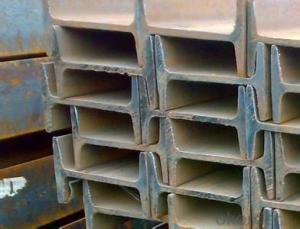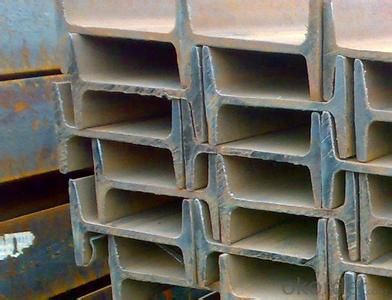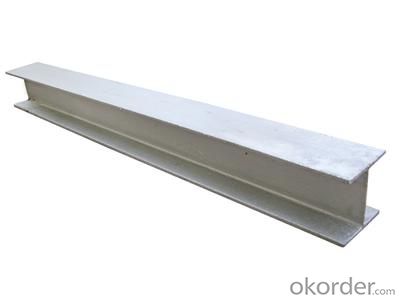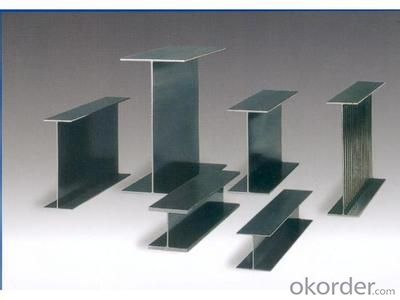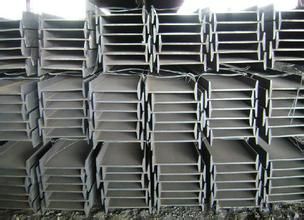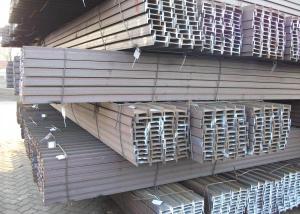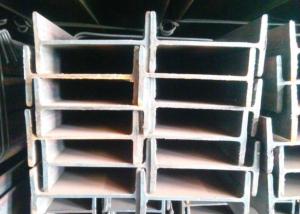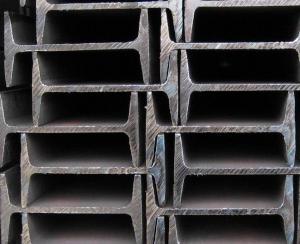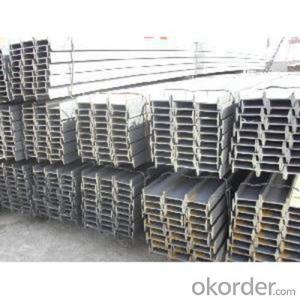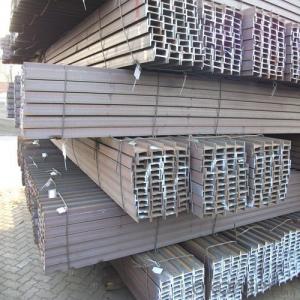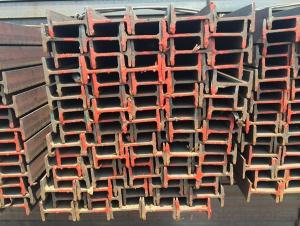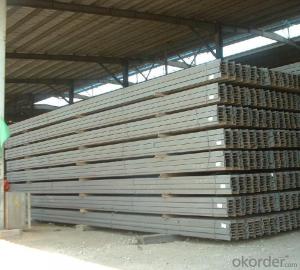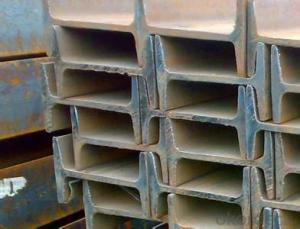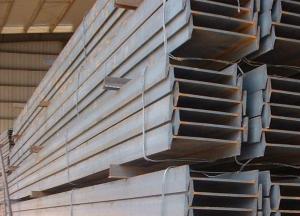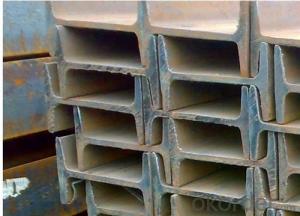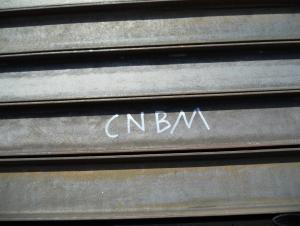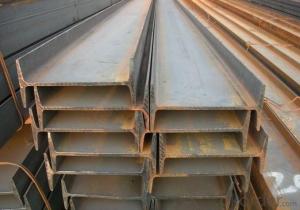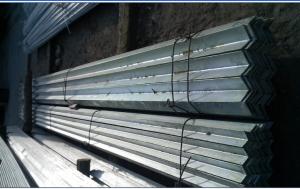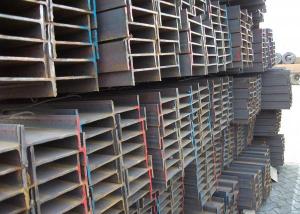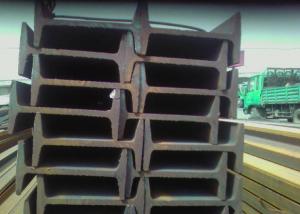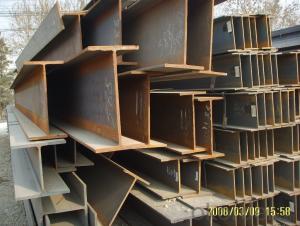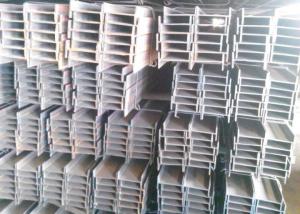High Quality BS Standard Structure Steel I Beam Details
- Loading Port:
- Tianjin
- Payment Terms:
- TT OR LC
- Min Order Qty:
- 500 m.t.
- Supply Capability:
- 20000 m.t./month
OKorder Service Pledge
OKorder Financial Service
You Might Also Like
High Quality BS Standard Structure Steel I Beam Details
Commodity | High Quality BS Standard Structure Steel I Beam |
Standard | BS, JIS, ASTM, DIN, EN, GB/T 700-1988 |
Material | SS400, ST37-2 , A36, S235 JRG1, Q235, Q345 and more |
Chinese standard size | 100 x 68 x 4.5 to 630 x 180 x 17mm |
European standard size | 80 x 46 x 3.8 to 600 x 220 x 12mm |
Length | 6, 9, 12meter |
Packing | bundles, knitting bag or customized |
Application | construction |
Packaging Detail: in bundle and then load on 20 or 40 feet container or by bulk
Delivery Detail: within 25 days after receiving deposit or original L/C
Company Information
Our company is specialized in producing Hot Rolled Metal Structural Steel I Beam .With years of development, our company won the trust and excellen reputation of customers for the quality of our products and sincere service, as well as foreign users of the community.
Please contact me if you are interested in our products and I will try my best to offer you the best goods and service.
- Q: No. 11 I-beam one meter multiple
- No. 10 I-beam weighs 11.261 kg per metre, and No. 12 I-beam weighs 13.987 kg per metre. GB No 11 i-beam.
- Q: What are the different types of steel I-beam profiles?
- In construction and engineering projects, a variety of steel I-beam profiles are commonly utilized. Some of the frequently encountered profiles are as follows: 1. W shape: This particular I-beam profile is widely employed due to its wide flanges and straight web. It offers exceptional strength and stability, making it suitable for a broad range of applications. 2. S shape: The S shape I-beam exhibits tapered flanges and a thinner web in comparison to the W shape. It is often employed in scenarios where lighter weight and flexibility are necessary, such as architectural and aesthetic applications. 3. HP shape: The HP shape I-beam, standing for "H-pile," is primarily used in deep foundation applications. Its distinguishing features include wide flanges and a thick web, providing remarkable load-bearing capacity in situations where high strength and stability are critical. 4. M shape: The M shape I-beam, also referred to as a "miscellaneous" shape, is less commonly encountered and typically utilized for specialized applications. It possesses unequal flanges and a thinner web, rendering it suitable for unique structural requirements. 5. L shape: The L shape I-beam, also known as angle iron, is characterized by its 90-degree angle and is commonly employed in smaller-scale structural applications, such as framing and support brackets. These examples represent a mere fraction of the diverse array of steel I-beam profiles that are available. The choice of profile depends on the specific project requirements, encompassing load-bearing capacity, size limitations, and aesthetic considerations.
- Q: Can steel I-beams be used in industrial or heavy-duty construction projects?
- Yes, steel I-beams are commonly used in industrial or heavy-duty construction projects due to their high strength and load-carrying capacity. They provide structural support and stability, making them ideal for applications that require durability and resistance to heavy loads or extreme conditions.
- Q: Can steel I-beams be used in convention centers or exhibition halls?
- Yes, steel I-beams can be used in convention centers or exhibition halls. Steel I-beams are commonly used in construction due to their strength and load-bearing capabilities, making them suitable for large spaces like convention centers and exhibition halls that require structural support.
- Q: How do steel I-beams contribute to the overall architectural design of a building?
- Steel I-beams play a crucial role in the overall architectural design of a building by providing structural support and stability. These beams are widely used in construction due to their high strength-to-weight ratio, which allows for the creation of large open spaces and flexible floor plans. One of the key contributions of steel I-beams is their ability to bear heavy loads over long spans, making them ideal for constructing tall buildings and bridges. The beams distribute the weight of the structure evenly, transferring it to the foundations and ensuring stability. This structural support enables architects to design buildings with expansive windows, open atriums, and large uninterrupted spaces, enhancing the aesthetic appeal and functionality of the structure. Moreover, steel I-beams offer design flexibility in terms of architectural style. They can be easily shaped and fabricated into various forms, allowing architects to create unique and visually appealing structures. The sleek and slender profile of these beams enables the construction of buildings with high ceilings and large open interiors, creating a sense of spaciousness and grandeur. Another significant contribution of steel I-beams to architectural design is their durability and resistance to natural disasters. Steel is known for its strength, durability, and resistance to fire, earthquakes, and extreme weather conditions. By incorporating steel I-beams, architects can design buildings that are not only aesthetically pleasing but also safe and long-lasting. Furthermore, the use of steel I-beams enables faster construction times due to their prefabricated nature. These beams can be manufactured off-site and then easily transported and assembled on-site, reducing construction time and costs. This advantage allows architects to meet tight deadlines and deliver projects efficiently. In summary, steel I-beams contribute significantly to the overall architectural design of a building by providing essential structural support, allowing for large open spaces, offering design flexibility, ensuring durability, and enabling faster construction. Their use enhances the aesthetic appeal, functionality, and safety of the structure, making them an integral part of modern architectural design.
- Q: What are the standard lengths of steel I-beams?
- The specific industry and application dictate the varying standard lengths of steel I-beams. In construction and engineering, the typical lengths for these beams range from 20 to 60 feet, making them the most frequently utilized. These lengths adhere to the demands of building codes and guarantee adequate support and structural integrity for a diverse array of construction endeavors. It is worth mentioning that tailored lengths can be produced to fulfill particular project requirements, albeit at an extra expense and potentially necessitating a special order.
- Q: How do steel I-beams contribute to the overall safety of a structure?
- A structure's overall safety is enhanced in numerous ways by the presence of steel I-beams. To begin with, their design and construction make them exceptionally strong and capable of withstanding bending or twisting forces. Consequently, they are able to bear heavy loads and distribute weight evenly across the structure. By providing a robust and stable framework, steel I-beams decrease the likelihood of structural collapse, guaranteeing the safety of the occupants. In addition, steel I-beams possess a significant level of fire resistance. Since steel has a high melting point, it can endure elevated temperatures for longer periods compared to materials like wood or concrete. This fire resistance diminishes the risk of structural failure during a fire, allowing occupants more time to safely evacuate the building. Furthermore, steel I-beams are exceptionally durable and long-lasting, displaying a high resistance to corrosion and degradation. This ensures that the structure remains intact and stable over time, reducing the chance of sudden failures or collapses. The strength and durability of steel I-beams also make them less susceptible to natural disasters such as earthquakes or strong winds, further bolstering the safety of the structure. In conclusion, steel I-beams contribute to the overall safety of a structure through their provision of a strong and stable framework, high fire resistance, and durability. Their ability to withstand heavy loads, distribute weight evenly, and resist bending or twisting forces guarantees the structural integrity of the building, minimizing the risk of collapse. When combined with their fire resistance and durability, steel I-beams offer a reliable and secure foundation for a safe structure.
- Q: What are the different design considerations for steel I-beams in industrial applications?
- Some of the key design considerations for steel I-beams in industrial applications include the load capacity required, the span length and support conditions, the desired deflection and stability, the potential for corrosion and fire resistance, as well as considerations related to fabrication, transportation, and installation. Additionally, factors such as cost, material availability, and the desired aesthetic appearance may also play a role in the design process.
- Q: Are steel I-beams environmentally friendly?
- Steel I-beams can be considered relatively environmentally friendly compared to other construction materials. Steel is a highly recyclable material, and the production of steel I-beams often includes a high percentage of recycled content. Additionally, steel is durable and has a long lifespan, which means that steel I-beams require less maintenance and replacement over time. This reduces the overall environmental impact of construction and minimizes waste. However, it is important to consider the energy-intensive process of manufacturing steel, which can contribute to greenhouse gas emissions. Nevertheless, the recyclability and durability of steel I-beams make them a preferable choice for many construction projects seeking to achieve sustainability goals.
- Q: What are the common finishes or coatings applied to steel I-beams?
- Steel I-beams can be enhanced in durability, aesthetic appeal, and corrosion resistance through the application of various finishes or coatings. Some commonly used options include: 1. Hot-dip galvanizing, which involves immersing the steel I-beams in molten zinc to create a protective layer that prevents rust and corrosion. This method is ideal for outdoor or high-moisture environments. 2. Powder coating, where a dry powder is applied to the steel I-beams and then cured under heat to form a durable finish. This process allows for a wide range of colors and textures, providing both protection against corrosion and aesthetic appeal. 3. Epoxy paint, which offers excellent adhesion and resistance to chemicals, making it suitable for harsh environments. Typically applied in multiple coats, epoxy paints create a tough barrier against corrosion. 4. Metallic coatings, such as aluminum or zinc, can be applied to steel I-beams using methods like electroplating or thermal spraying. These coatings provide a sacrificial layer that corrodes before the steel, thus extending the lifespan of the I-beams. 5. Primer/topcoat systems provide additional protection by coating the steel I-beams with a primer to enhance adhesion, followed by a topcoat for aesthetic appeal and resistance to corrosion. This type of system is commonly used in architectural or decorative applications. It is important to consider the intended use and environmental conditions when choosing a finish or coating for steel I-beams. Seeking advice from professionals or manufacturers can assist in determining the most suitable option for specific requirements.
Send your message to us
High Quality BS Standard Structure Steel I Beam Details
- Loading Port:
- Tianjin
- Payment Terms:
- TT OR LC
- Min Order Qty:
- 500 m.t.
- Supply Capability:
- 20000 m.t./month
OKorder Service Pledge
OKorder Financial Service
Similar products
Hot products
Hot Searches
Related keywords
